15.7E: Exercícios para a Seção 15.7
- Page ID
- 188114
Nos exercícios 1 a 6, a função\(T : S \rightarrow R, \space T (u,v) = (x,y)\) na região\(S = \big\{(u,v) \,|\, 0 \leq u \leq 1, \space 0 \leq v \leq 1\big\}\) delimitada pela unidade quadrada é dada, onde\(R \in R^2\) está a imagem de\(S\) abaixo\(T\).
a. Justifique que a função\(T\) é uma\(C^1\) transformação.
b. Encontre as imagens dos vértices da unidade quadrada\(S\) por meio da função\(T\).
c. Determine a imagem\(R\) da unidade quadrada\(S\) e represente-a graficamente.
1. \(x = 2u, \space y = 3v\)
2. \(x = \frac{u}{2}, \space y = \frac{v}{3}\)
- Resposta
-
a.\(T(u,v) = (g(u,v), \space h(u,v), \space x = g(u,v) = \frac{u}{2}\)\(y = h(u,v) = \frac{v}{3}\) e. As funções\(g\)\(h\) são contínuas e diferenciáveis, e as derivadas parciais\(g_u (u,v) = \frac{1}{2}, \space g_v (u,v) = 0, \space h_u (u,v) = 0\) e\(h_v (u,v) = \frac{1}{3}\) são contínuas\(S\);
b.\(T(0,0) = (0,0), \space T(1,0) = \left(\frac{1}{2},0\right), \space T(0,1) = \left(0,\frac{1}{3}\right)\), e\(T(1,1) = \left(\frac{1}{2}, \frac{1}{3} \right)\);
c.\(R\) é o retângulo de vértices\((0,0), \space \left(0,\frac{1}{3}\right), \space \left(\frac{1}{2}, \frac{1}{3} \right)\) e\(\left(0,\frac{1}{3}\right)\) no\(xy\) plano -; a figura a seguir.
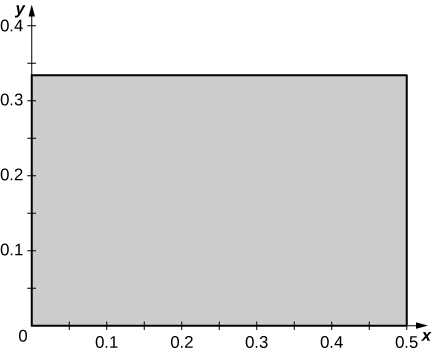
3. \(x = u - v, \space y = u + v\)
4. \(x = 2u - v, \space y = u + 2v\)
- Answer
-
a. \(T(u,v) = (g(u,v), \space h(u,v), \space x = g(u,v) = 2u - v\) and \(y = h(u,v) = u + 2v\). The functions \(g\) and \(h\) are continuous and differentiable, and the partial derivatives \(g_u (u,v) = 2, \space g_v (u,v) = -1, \space h_u (u,v) = 1\) and \(h_v (u,v) = 2\) are continuous on \(S\);
b. \(T(0,0) = (0,0), \space T(1,0) = (2,1), \space T(0,1) = (-1,2)\), and \(T(1,1) = (1,3)\);
c. \(R\) is the parallelogram of vertices \((0,0), \space (2,1) \space (1,3)\), and \((-1,2)\) in the \(xy\)-plane; the following figure.
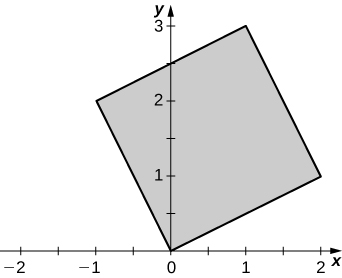
5. \(x = u^2, \space y = v^2\)
6. \(x = u^3, \space y = v^3\)
- Resposta
-
a.\(T(u,v) = (g(u,v), \space h(u,v), \space x = g(u,v) = u^3\)\(y = h(u,v) = v^3\) e. As funções\(g\)\(h\) são contínuas e diferenciáveis, e as derivadas parciais\(g_u (u,v) = 3u^2, \space g_v (u,v) = 0, \space h_u (u,v) = 0\) e\(h_v (u,v) = 3v^2\) são contínuas\(S\);
b.\(T(0,0) = (0,0), \space T(1,0) = (1,0), \space T(0,1) = (0,1)\), e\(T(1,1) = (1,1)\);
c.\(R\) é a unidade quadrada no\(xy\) plano -veja a figura na resposta ao exercício anterior.
Nos exercícios 7 a 12, determine se as transformações\(T : S \rightarrow R\) são individuais ou não.
7. \(x = u^2, \space y = v^2\), onde\(S\) está o retângulo de vértices\((-1,0), \space (1,0), \space (1,1)\),\((-1,1)\) e.
8. \(x = u^4, \space y = u^2 + v\), onde\(S\) está o triângulo de vértices\((-2,0), \space (2,0)\),\((0,2)\) e.
- Resposta
- \(T\)não é um para um: dois pontos\(S\) têm a mesma imagem. De fato,\(T(-2,0) = T(2,0) = (16,4)\).
9. \(x = 2u, \space y = 3v\), onde\(S\) é o quadrado dos vértices\((-1,1), \space (-1,-1), \space (1,-1)\),\((1,1)\) e.
10. \(T(u, v) = (2u - v, u),\)onde\(S\) está o triângulo com vértices\((-1,1), \, (-1,-1)\),\((1,-1)\) e.
- Resposta
- \(T\)é individual: argumentamos por contradição. \(T(u_1,v_1) = T(u_2,v_2)\)implica\(2u_1 - v_1 = 2u_2 - v_2\)\(u_1 = u_2\) e. Assim,\(u_1 = u+2\)\(v_1 = v_2\) e.
11. \(x = u + v + w, \space y = u + v, \space z = w\), onde\(S = R = R^3\).
12. \(x = u^2 + v + w, \space y = u^2 + v, \space z = w\), onde\(S = R = R^3\).
- Resposta
- \(T\)não é um para um:\(T(1,v,w) = (-1,v,w)\)
Nos exercícios 13 a 18, as transformações\(T : R \rightarrow S\) são individuais. Encontre suas transformações inversas relacionadas\(T^{-1} : R \rightarrow S\).
13. \(x = 4u, \space y = 5v\), onde\(S = R = R^2\).
14. \(x = u + 2v, \space y = -u + v\), onde\(S = R = R^2\).
- Resposta
- \(u = \frac{x-2y}{3}, \space v= \frac{x+y}{3}\)
15. \(x = e^{2u+v}, \space y = e^{u-v}\), onde\(S = R^2\) e\(R = \big\{(x,y) \,|\, x > 0, \space y > 0\big\}\)
16. \(x = \ln u, \space y = \ln(uv)\), onde\(S = \big\{(u,v) \,|\, u > 0, \space v > 0\big\}\)\(R = R^2\) e.
- Resposta
- \(u = e^x, \space v = e^{-x+y}\)
17. \(x = u + v + w, \space y = 3v, \space z = 2w\), onde\(S = R = R^3\).
18. \(x = u + v, \space y = v + w, \space z = u + w\), onde\(S = R = R^3\).
- Resposta
- \(u = \frac{x-y+z}{2}, \space v = \frac{x+y-z}{2}, \space w = \frac{-x+y+z}{2}\)
Nos exercícios 19 a 22, a transformação\(T : S \rightarrow R, \space T (u,v) = (x,y)\) e a região\(R \subset R^2\) são dadas. Encontre a região\(S \subset R^2\).
19. \(x = au, \space y = bv, \space R = \big\{(x,y) \,|\, x^2 + y^2 \leq a^2 b^2\big\}\)onde\(a,b > 0\)
20. \(x = au, \space y = bc, \space R = \big\{(x,y) \,|\, \frac{x^2}{a^2} + \frac{y^2}{b^2} \leq 1\big\}\), onde\(a,b > 0\)
- Resposta
- \(S = \big\{(u,v) \,|\, u^2 + v^2 \leq 1\big\}\)
21. \(x = \frac{u}{a}, \space y = \frac{v}{b}, \space z = \frac{w}{c}, \space R = \big\{(x,y)\,|\,x^2 + y^2 + z^2 \leq 1\big\}\), onde\(a,b,c > 0\)
22. \(x = au, \space y = bv, \space z = cw, \space R = \big\{(x,y)\,|\,\frac{x^2}{a^2} - \frac{y^2}{b^2} - \frac{z^2}{c^2} \leq 1, \space z > 0\big\}\), onde\(a,b,c > 0\)
- Resposta
- \(R = \big\{(u,v,w)\,|\,u^2 - v^2 - w^2 \leq 1, \space w > 0\big\}\)
Nos exercícios 23 a 32, encontre o Jacobiano\(J\) da transformação.
23. \(x = u + 2v, \space y = -u + v\)
24. \(x = \frac{u^3}{2}, \space y = \frac{v}{u^2}\)
- Resposta
- \(\frac{3}{2}\)
25. \(x = e^{2u-v}, \space y = e^{u+v}\)
26. \(x = ue^v, \space y = e^{-v}\)
- Resposta
- \(-1\)
27. \(x = u \space \cos (e^v), \space y = u \space \sin(e^v)\)
28. \(x = v \space \sin (u^2), \space y = v \space \cos(u^2)\)
- Resposta
- \(2uv\)
29. \(x = u \space \cosh v, \space y = u \space \sinh v, \space z = w\)
30. \(x = v \space \cosh \left(\frac{1}{u}\right), \space y = v \space \sinh \left(\frac{1}{u}\right), \space z = u + w^2\)
- Resposta
- \(\frac{v}{u^2}\)
31. \(x = u + v, \space y = v + w, \space z = u\)
32. \(x = u - v, \space y = u + v, \space z = u + v + w\)
- Resposta
- \(2\)
33. A região triangular\(R\) com os vértices\((0,0), \space (1,1)\), e\((1,2)\) é mostrada na figura a seguir.
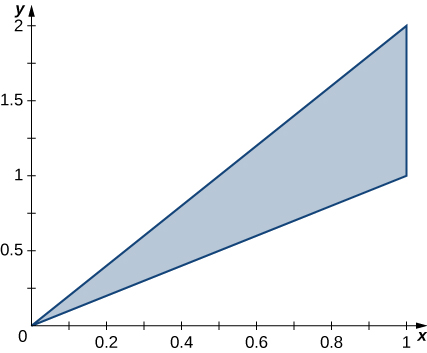
a. Encontre uma transformação\(T : S \rightarrow R, \space T(u,v) = (x,y) = (au + bv + dv)\), where \(a,b,c\), and \(d\) are real numbers with \(ad - bc \neq 0\) such that \(T^{-1} (0,0) = (0,0), \space T^{-1} (1,1) = (1,0)\), and \(T^{-1}(1,2) = (0,1)\).
b. Use the transformation \(T\) to find the area \(A(R)\) of the region \(R\).
34. The triangular region \(R\) with the vertices \((0,0), \space (2,0)\), and \((1,3)\) is shown in the following figure.

a. Encontre uma transformação\(T : S \rightarrow R, \space T(u,v) = (x,y) = (au + bv + dv)\)\(a,b,c\), onde e\(d\) são números reais com\(ad - bc \neq 0\) tal que\(T^{-1} (0,0) = (0,0), \space T^{-1} (2,0) = (1,0)\),\(T^{-1}(1,3) = (0,1)\) e.
b. Use a transformação\(T\) para encontrar a área\(A(R)\) da região\(R\).
- Resposta
-
a.\(T (u,v) = (2u + v, \space 3v)\)
b. A área de\(R\) é\(\displaystyle A(R) = \int_0^3 \int_{y/3}^{(6-y)/3} \, dx \, dy = \int_0^1 \int_0^{1-u} \left|\frac{\partial (x,y)}{\partial (u,v)}\right| \, dv \space du = \int_0^1 \int_0^{1-u} 6 \, dv \, du = 3.\)
Nos exercícios 35 a 36, use a transformação\(u = y - x, \space v = y\), para avaliar as integrais no paralelogramo\(R\) dos vértices\((0,0), \space (1,0), \space (2,1)\), e\((1,1)\) mostrada na figura a seguir.
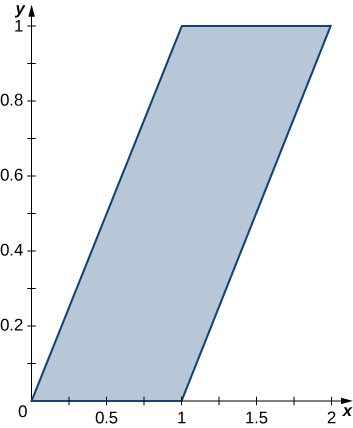
35. \(\displaystyle \iint_R (y - x) \, dA\)
36. \(\displaystyle \iint_R (y^2 - xy) \, dA\)
- Answer
- \(-\frac{1}{4}\)
In exercises 37 - 38, use the transformation \(y = x = u, \space x + y = v\) to evaluate the integrals on the square \(R\) determined by the lines \(y = x, \space y = -x + 2, \space y = x + 2\), and \(y = -x\) shown in the following figure.
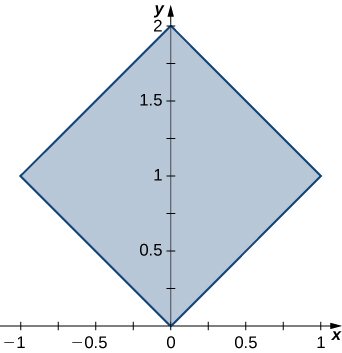
37. \(\displaystyle \iint_R e^{x+y} \, dA\)
38. \(\displaystyle \iint_R \sin (x - y) \, dA\)
- Resposta
- \(-1 + \cos 2\)
Nos exercícios 39 a 40, use a transformação\(x = u, \space 5y = v\) para avaliar as integrais na região\(R\) delimitada pela elipse\(x^2 + 25y^2 = 1\) mostrada na figura a seguir.

39. \(\displaystyle \iint_R \sqrt{x^2 + 25y^2} \, dA\)
40. \(\displaystyle \iint_R (x^2 + 25y^2)^2 \, dA\)
- Answer
- \(\frac{\pi}{15}\)
In exercises 41 - 42, use the transformation \(u = x + y, \space v = x - y\) to evaluate the integrals on the trapezoidal region \(R\) determined by the points \((1,0), \space (2,0), \space (0,2)\), and \((0,1)\) shown in the following figure.
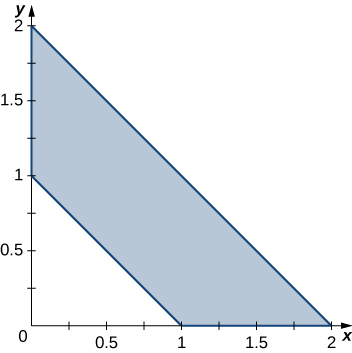
41. \(\displaystyle \iint_R (x^2 - 2xy + y^2) \space e^{x+y} \, dA\)
42. \(\displaystyle \iint_R (x^3 + 3x^2y + 3xy^2 + y^3) \, dA\)
- Resposta
- \(\frac{31}{5}\)
43. O setor circular do anel\(R\) delimitado pelos círculos\(4x^2 + 4y^2 = 1\) e\(9x^2 + 9y^2 = 64\), a linha\(x = y \sqrt{3}\) e o\(y\) eixo -é mostrado na figura a seguir. Encontre uma transformação\(T\) de uma região retangular\(S\) no\(r\theta\) plano -para a região\(R\) no\(xy\) plano -. Gráfico\(S\).
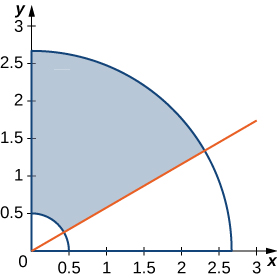
44. O sólido\(R\) bounded by the circular cylinder \(x^2 + y^2 = 9\) and the planes \(z = 0, \space z = 1, \space x = 0\), and \(y = 0\) is shown in the following figure. Find a transformation \(T\) from a cylindrical box \(S\) in \(r\theta z\)-space to the solid \(R\) in \(xyz\)-space.
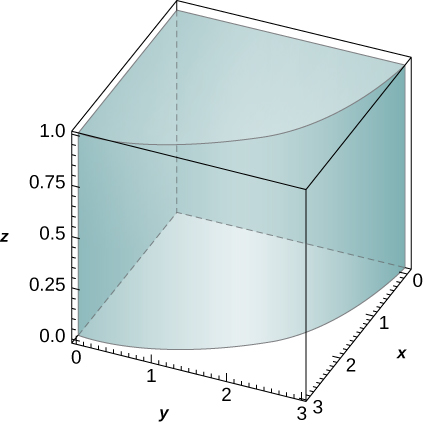
- Resposta
- \(T (r,\theta,z) = (r \space \cos \theta, \space r \space \sin \theta, \space z); \space S = [0,3] \times [0,\frac{\pi}{2}] \times [0,1]\)no\(r\theta z\) espaço -
45. Mostre que\[\iint_R f \left(\sqrt{\frac{x^2}{3} + \frac{y^2}{3}}\right) dA = 2 \pi \sqrt{15} \int_0^1 f (\rho) \rho \space d\rho, \nonumber \] onde\(f\) está uma função contínua ativada\([0,1]\) e\(R\) é a região delimitada pela elipse\(5x^2 + 3y^2 = 15\).
46. Mostre que\[\iiint_R f \left(\sqrt{16x^2 + 4y^2 + z^2}\right) dV = \frac{\pi}{2} \int_0^1 f (\rho) \rho^2 d\rho, \nonumber \] onde\(f\) está uma função contínua ativada\([0,1]\) e\(R\) é a região delimitada pelo elipsóide\(16x^2 + 4y^2 + z^2 = 1\).
47. [T] Encontre a área da região delimitada pelas curvas\(xy = 1, \space xy = 3, \space y = 2x\) e\(y = 3x\) usando a transformação\(u = xy\)\(v = \frac{y}{x}\) e. Use um sistema computacional de álgebra (CAS) para representar graficamente as curvas de limite da região\(R\).
48. [T] Encontre a área da região delimitada pelas curvas\(x^2y = 2, \space x^2y = 3, \space y = x\) e\(y = 2x\) usando a transformação\(u = x^2y\)\(v = \frac{y}{x}\) e. Use um CAS para representar graficamente as curvas de limite da região\(R\).
- Resposta
-
A área de\(R\) é\(10 - 4\sqrt{6}\); as curvas de limite de\(R\) são representadas graficamente na figura a seguir.
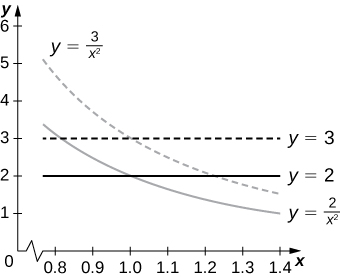
49. Avalie a integral tripla\[\int_0^1 \int_1^2 \int_z^{z+1} (y + 1) \space dx \space dy \space dz \nonumber \] by using the transformation \(u = x - z, \space v = 3y\), and \(w = \frac{z}{2}\).
50. Evaluate the triple integral \[\int_0^2 \int_4^6 \int_{3z}^{3z+2} (5 - 4y) \space dx \space dy \space dz \nonumber \] by using the transformation \(u = x - 3z, \space v = 4y\), and \(w = z\).
- Answer
- \(8\)
51. A transformation \(T : R^2 \rightarrow R^2, \space T (u,v) = (x,y)\) of the form \(x = au + bv, \space y = cu + dv\), where \(a,b,c\), and \(d\) are real numbers, is called linear. Show that a linear transformation for which \(ad - bc \neq 0\) maps parallelograms to parallelograms.
52. A transformation \(T_{\theta} : R^2 \rightarrow R^2, \space T_{\theta} (u,v) = (x,y)\) of the form \(x = u \space \cos \theta - v \space \sin \theta, \space y = u \space \sin \theta + v \space \cos \theta\), is called a rotation angle \(\theta\). Show that the inverse transformation of \(T_{\theta}\) satisfies \(T_{\theta}^{-1} = T_{-\theta}\) where \(T_{-\theta}\) is the rotation of angle \(-\theta\).
53. [T] Find the region \(S\) in the \(uv\)-plane whose image through a rotation of angle \(\frac{\pi}{4}\) is the region \(R\) enclosed by the ellipse \(x^2 + 4y^2 = 1\). Use a CAS to answer the following questions.
a. Graph the region \(S\).
b. Evaluate the integral \(\displaystyle \iint_S e^{-2uv} \, du \, dv.\) Round your answer to two decimal places.
54. [T] The transformations \(T_i : \mathbb{R}^2 \rightarrow \mathbb{R}^2, \space i = 1, . . . , 4,\) defined by \(T_1(u,v) = (u,-v), \space T_2 (u,v) = (-u,v), \space T_3 (u,v) = (-u, -v)\), and \(T_4 (u,v) = (v,u)\) are called reflections about the \(x\)-axis, \(y\)-axis origin, and the line \(y = x\), respectively.
a. Find the image of the region \(S = \big\{(u,v)\,|\,u^2 + v^2 - 2u - 4v + 1 \leq 0\big\}\) in the \(xy\)-plane through the transformation \(T_1 \circ T_2 \circ T_3 \circ T_4\).
b. Use a CAS to graph \(R\).
c. Evaluate the integral \(\displaystyle \iint_S \sin (u^2) \, du \, dv\) by using a CAS. Round your answer to two decimal places.
- Answer
-
a. \(R = \big\{(x,y)\,|\,y^2 + x^2 - 2y - 4x + 1 \leq 0\big\}\);
b. \(R\) is graphed in the following figure;
c.\(3.16\)
55. [T] As transformações\(T_{k,1,1} : \mathbb{R}^3 \rightarrow \mathbb{R}^3, \space T_{k,1,1}(u,v,w) = (x,y,z)\) da forma\(x = ku, \space y = v, \space z = w\), onde\(k \neq 1\) há um número real positivo, são chamadas de alongamento se\(k > 1\) e compressão se\(0 < k < 1\) na\(x\) direção -. Use um CAS para avaliar a integral\(\displaystyle \iiint_S e^{-(4x^2+9y^2+25z^2)} \, dx \, dy \, dz\) no sólido\(S = \big\{(x,y,z) \,|\, 4x^2 + 9y^2 + 25z^2 \leq 1\big\}\) considerando a compressão\(T_{2,3,5}(u,v,w) = (x,y,z)\) definida por\(x = \frac{u}{2}, \space y = \frac{v}{3}\)\(z = \frac{w}{5}\) e. Arredonde sua resposta para quatro casas decimais.
56. [T] A transformação\(T_{a,0} : \mathbb{R}^2 \rightarrow \mathbb{R}^2, \space T_{a,0} (u,v) = (u + av, v)\), onde\(a \neq 0\) está um número real, é chamada de distorção na\(x\) direção. A transformação\(T_{b,0} : R^2 \rightarrow R^2, \space T_{o,b}(u,v) = (u,bu + v)\), onde\(b \neq 0\) está um número real, é chamada de distorção na\(y\) direção.
a. Encontre transformações\(T_{0,2} \circ T_{3,0}\).
b. Encontre a imagem\(R\) da região trapezoidal\(S\) delimitada por\(u = 0, \space v = 0, \space v = 1\) e\(v = 2 - u\) através da transformação\(T_{0,2} \circ T_{3,0}\).
c. Use um CAS para representar graficamente a imagem\(R\) no\(xy\) plano.
d. Encontre a área da região\(R\) usando a área da região\(S\).
- Resposta
-
uma\(T_{0,2} \circ T_{3,0}(u,v) = (u + 3v, 2u + 7v)\);.
b. A imagem\(S\) é o quadrilátero dos vértices\((0,0), \space (3,7), \space (2,4)\) e\((4,9)\);
c.\(S\) é representado graficamente na figura a seguir;
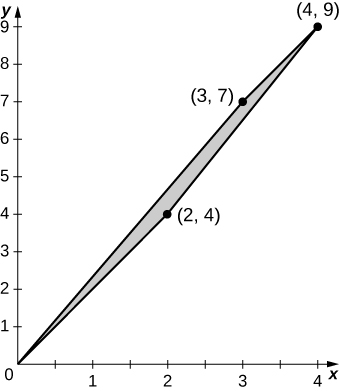
d.

